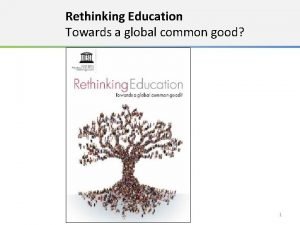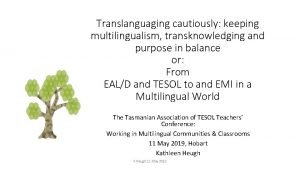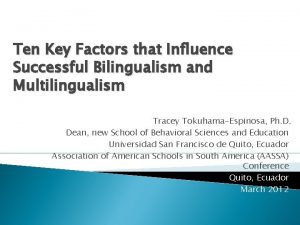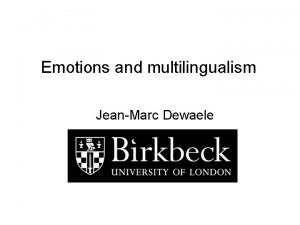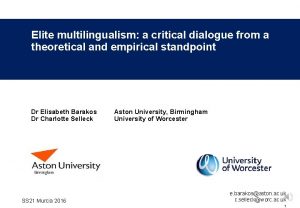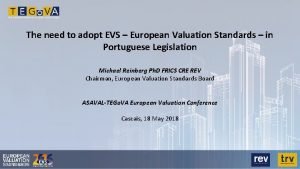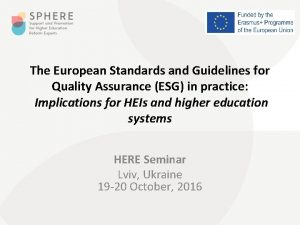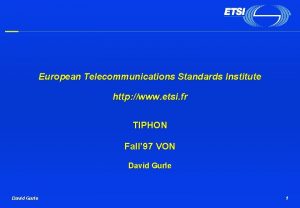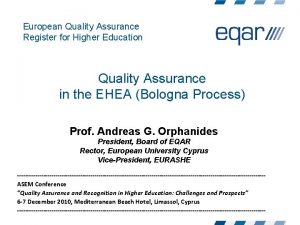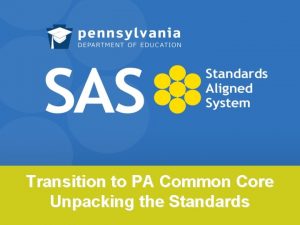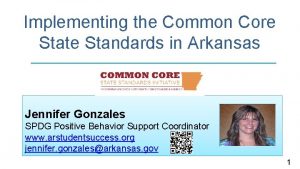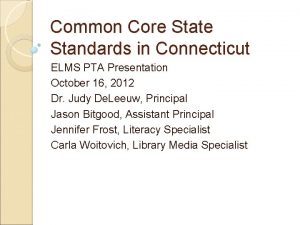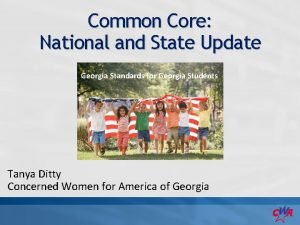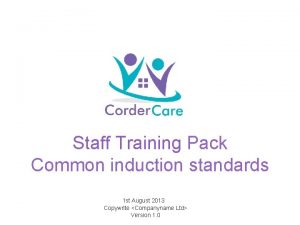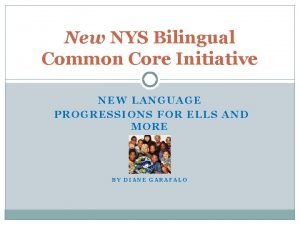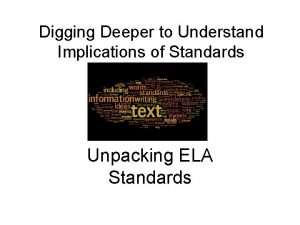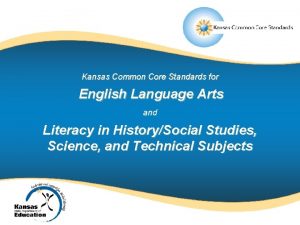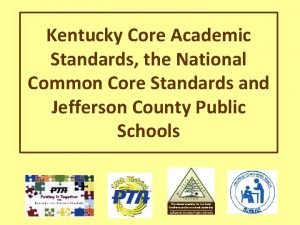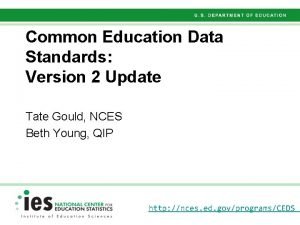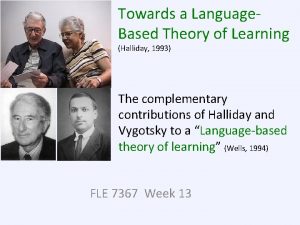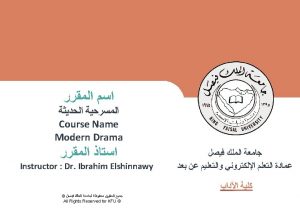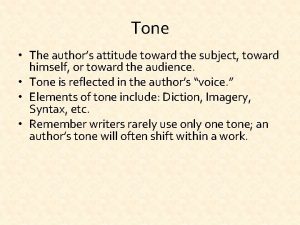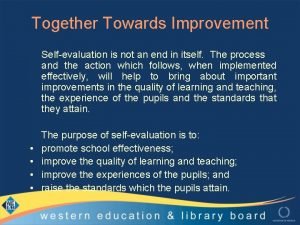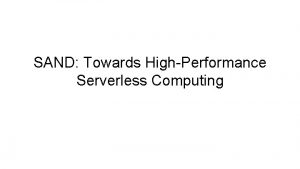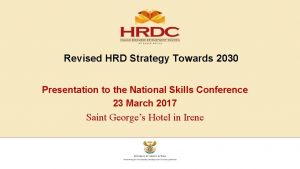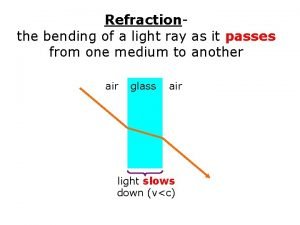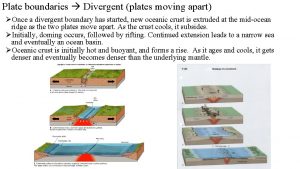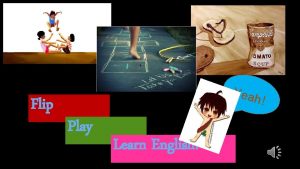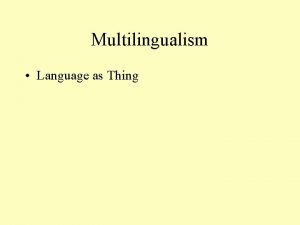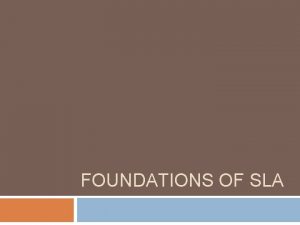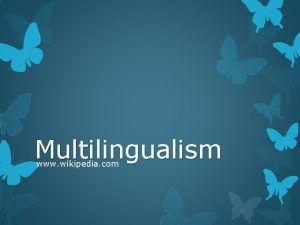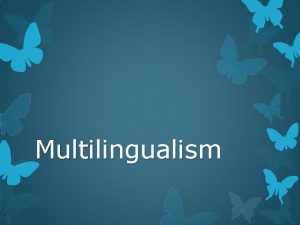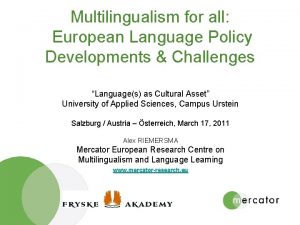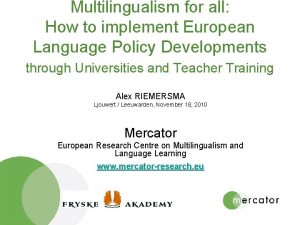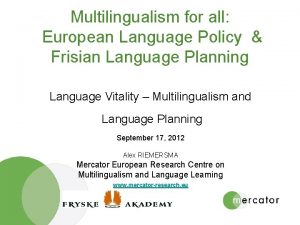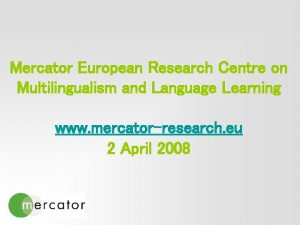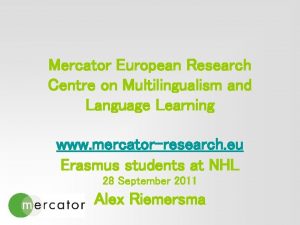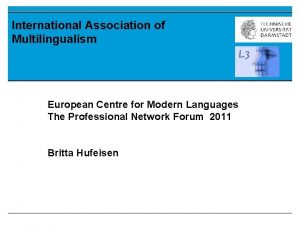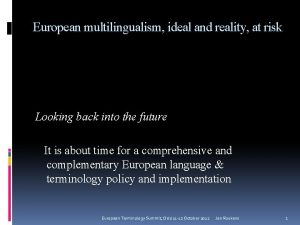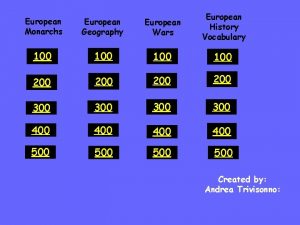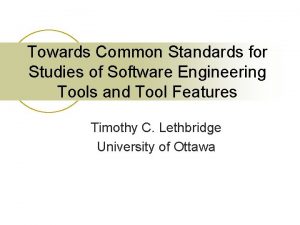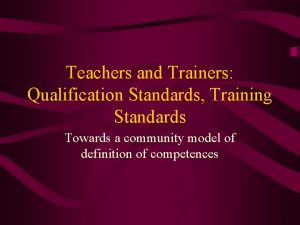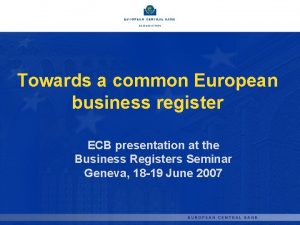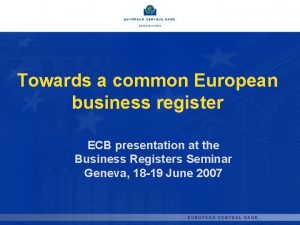Multilingualism for all Towards Common Standards for European









































- Slides: 41

Multilingualism for all: Towards Common Standards for European Linguistic Diversity Bangor (Gwynedd, Wales), 27 February, 2012 Alex RIEMERSMA Mercator European Research Centre on Multilingualism and Language Learning www. mercator-research. eu

Overview of presentation · European Linguistic Diversity · European Charter for RMLs · Unesco Language Vitality Index · Examples: Frisian, Welsh, Catalan · Common Standards: Charter & CEFR · Research Agenda

Kaart fan NOS

European Linguistic Diversity · Council of Europe (1949; 47 states): 6 working languages > hundreds of living languages · European Union (1957; 27 states): 23 official / working languages > 60 Regional and Minority Languages > 175 Migrant Languages · Reality: No monolingual states

EU Linguistic Reality · 60 RMLs >>>10% of EU population · 175 Immigrant Languages · 45 – 50 million RML speakers · Millions of Immigrant Language speakers in all EU member states = · All EU states Multilingual Societies >>> Co-responsibility for language planning with national and regional authorities

Council of Europe Charter for RMLs (1998) · To protect and to promote RMLs = programmatic approach · Domains: education / justice / public services / media / culture / social life · All inclusive spirit > holistic approach · Monitoring system: - International Committee of Experts - National Consulting Body

Council of Europe Charter for RMLs (1998) · Application at national level · Entry exam for new EU states (2004) However: · 25 ratifications (< 47 Co. E member states) · 13 ratifications (< 27 EU member states)

EU Language Policy (1) · Fund. Rights (art. 22): EU shall respect cultural, religious and linguistic diversity · Linguistic diversity: all languages are equal and equally treated · Barcelona (2002): Mother tongue + 2 · Action Plan 2004 -2006 · Communication 2005; 2008 · Co-operation with Council of Europe

EU Language Policy (2) However: · Mother tongue = state language · Principle of “subsidiarity” · Process of mainstreaming · No Agency for Linguistic Diversity prevents EU Language Policy in favour of RMLs & discourages vitality of RMLs

EU Network Initiatives · EU Parliament initiatives: · EBLUL (1982 -2010): 19 MSC’s · Mercator Network (1987): 5 partners (www. mercator-research. eu) · Language Boards’ initiative: · Network to Promote Linguistic Diversity (2009): 11 regional authorities + 17 NGOs (www. npld. eu)

Initiatives to research agenda · 2010 -2012: European Network of Universities on Multilingualism (EUNo. M): 7 full partners & followers http: //eunom. uoc. edu · 2011 -2013: EU Civil Society Platform on Multilingualism / Poliglotti: 30 partners www. poliglotti 4. eu

Research Agenda Themes · Personal multilingualism · Multilingualism of Society or: · Corpus Planning · Status Planning · Language Acquisition Planning or: · (all inclusive) Language Vitality

Unesco Language Vitality (2003)

Language Vitality factors (6) · (1) Intergenerational transmission · (2) Absolute number and (3) proportion of speakers · (4) Trends / shift in domains · (5) Response to new domains & media · (6) Materials for Education and Literacy

Language Vitality factors (3) · (7) Governmental and Institutional Language Attitudes & Politics · (8) Community Member’s Attitudes towards their own languages · (9) Documentation (& corpus planning) http: //www. unesco. org

Tools for Common Approach multilingualism of society: · Unesco Vitality Index · Charter RMLs (signed) undertakings · Common European Framework of Reference – Grid (can do) and levels individual multilingualism: · Language Portfolio (electronic) · Student Monitoring System L 1 -L 2 -Lf

Example: Vitality of Frisian · (2)350. 000 mother tongue speakers · (3) 54% of population of Friesland · Language command of all 640. 00 inhabitants province of Fryslân: · 94 % Understanding · 74 % Speaking · 65 % Reading · 17 % Writing

Example: Vitality of Frisian · (1) weak position in language mixed families · (6) marginal position in education > Charter RMLs - level: ii / iii · (7) strong provincial support, but weak national legislation · (8) vacillating attitude: awareness - but no consequent language use

Example: Vitality of Welsh · (1) Threatened language transmission in mixed families, but: TWF initiative & Mudiad Meithrin good attempts to Reversing Language Shift · (2) + (3) Census Data 2011 etc. ; see: Hywel M. Jones, Welsh: a statistical overview of the Welsh language (February 2012) · (4) All domains covered (also church !) · (5) Welsh is ‘cool’ – but ‘cool enough’?

Example: Vitality of Welsh · (6) Welsh in education is strong: subject, medium, continuity, quality > Charter RMLs - level i Advantage: students take GCDSE & GNVQ external examinations in Welsh But: 50% of parents in favour, only 20% of children receive bilingual education Therefore: “micro-language planning”

Example: Vitality of Welsh · (7) Strong support by Welsh Assembly and Welsh Language Act, result of process of Devolvement of Power · (8) Strong Attitudes among authorities at all levels, but … lip service & window dressing

Example: Vitality of Welsh · (8) Active in use (orally & in writing) in all domains, but … · Visibility of the language = linguistic landscape · (9) Corpus Planning, including electronic media applications

Example: Vitality of Catalan · (1) 52% Catalan; 41% Spanish · (2) Catalunya (6 Million): 97. 5% can understand 90. 5 % can read 85 % can speak 62. 3 % can write · (4) + (5): a “must” in all domains

Example: Vitality of Catalan · (6): Standardisation (“normalisation”) Law (1983) / Decree (1988; 1992): Catalan medium of instruction at all levels of education & immersion programmes & trilingual education programmes > Charter RMLS – level i · Inspectorate of Autonomous Region

Example: Vitality of Catalan · (7): strong support by autonomous government of Catalunya; Statute of Autonomy (1979) includes Catalan Language Act · (8): strong pro-Catalan and anti-Madrid attitude; activistic use in all domains · (9): Bilingual newspaper “El Periodico” plenty of documentation, standardisation etc.

Unesco Index & Co. E Charter · Description of individual languages within one state (no cross border descriptions) · Lack of overarching common understanding & · Lack of common policy · Comex’ frustrations on implementation

Options for Action · “Dim byd” · Common Policies of Co. E & EU · Research projects towards: - common understanding - pre-conditions for common policies

Research Agenda (1) · Comparative studies on Charter: levels of signed undertakings from part III · Comparative studies on CEFR: intended target levels for RML / IML education · Vitality Index: redefinition of subscales and concept of “plurilingualism”

Research Agenda (2) · Comparative studies on CEFR: comparable results of L 1 - L 2 - Lf > · Student Monitoring System L 1 - L 2 - Lf · Multilingual education: - continuity of curriculum - content & language integrated learning - teacher qualifications (Lisbon Treaty!) · Redefining Plurilingual Literacy

Comparative Studies · Euromosaic (1996; 2004; 2009) with “ranking” of RMLs on 7 domains. · Mercator Study (2007) Development of Minimum Standards on Language Education in RMLs http: //www. mercator-research. eu/news/publications/ - Based on Mercator Regional Dossiers & - National reports on Charter for RMLs

Member States & Languages · Austria: · Germany: · Netherlands: · Slovakia: · Slovenia: · Spain: · Sweden: · United Kingdom: Slovenian, Croatian Sorbian Frisian Hungarian Italian Catalan Sami Welsh

Charter Article 8: Education · Teaching OF and teaching IN · Pre-primary provisions · Primary school · Secondary education · Teacher training · Adult education

Levels of ratification · Level i: immersion / language of instruction · Level ii: substantial part · Level iii: integral part · Level iv: on request of parents

Themes of analysis · Educational goals & models · Time spent · Teaching materials · Teacher training · Inspectorate · Legal position

Comex’ interpretation art. 8 · Level i: the minority language is used at school for more than 50% of lessons · Level ii: “Substantial part”: in primary education – more than 6 hours per week in secondary education: 30% of education time · Level iii: “Integral part”: in primary education several subjects in secondary education at least the minority language as a compulsory subject

Application of CEFR (2001) · Common European Framework of Reference · Grid of Language skills: listening, reading, talking and speaking, writing · Levels: · A: Threshold / B: Way stage / C: Mastery · - can do – statements for L 1, L 2, Lf - parallel assessments of L 1, L 2, Lf

Language Vitality Planning · Balance of community language will and infrastructure / programmes on: · Corpus planning / standardisation · Status planning / legislation · Language transmission / learning

Towards EU Language Policy · Legal base / Treaty partner to European Charter for RML · Eurobarometer on Languages: Mother tongue + father tongue / Language of preference · Vitality & empowerment of all languages · Co-responsibility in stead of “subsidiarity” · Aiming at “inclusiveness” of RML / IML · Partnership to permanent networks of stakeholders for regular strategic review

References · Unesco Expert Group (2003) Language Vitality and Endangerement http: //www. unesco. org/culture/ich/doc/src/00120 -EN. pdf · The Development of Minimum Standards on Language Education in RMLs (2007) http: //www. mercatorresearch. eu/fileadmin/mercator/publications_pdf/final%20 reportdef%20 Minimum%20 Standards. pdf · Euromosaic (1996; 2004; 2009) summary: http: //ec. europa. eu/languages/documents/euromosaic-studycomparative-summary_en. pdf · Trilingual Primary Education in Europe (2011) http: //www. mercatorresearch. eu/fileadmin/mercator/publications_pdf/trilingual_primary_ education_def. pdf


• Köszönöm Tankewol • Eskerrik asko • Grazia • Mercé plan • Dankscheen • Graciis • Kiitos • Diolch • Hvala • Trugarez • Dz'akuju so • Merci • Multumesc • Mange Takk
 Types of societal multilingualism
Types of societal multilingualism Rethinking education: towards a global common good?
Rethinking education: towards a global common good? Horizontal and vertical multilingualism
Horizontal and vertical multilingualism Factors affecting bilingualism
Factors affecting bilingualism Jean-marc dewaele
Jean-marc dewaele Elite multilingualism
Elite multilingualism Name a line containing point a
Name a line containing point a European quality assurance standards
European quality assurance standards European valuation standards
European valuation standards European standards and guidelines for quality assurance
European standards and guidelines for quality assurance European telecommunications standards institute
European telecommunications standards institute European standards of care for newborn health
European standards of care for newborn health European quality assurance register for higher education
European quality assurance register for higher education Factors necessary for service standards are
Factors necessary for service standards are Pa common core standards
Pa common core standards Common core state standards arkansas
Common core state standards arkansas Connecticut common core state standards
Connecticut common core state standards Georgia common core standards
Georgia common core standards Common induction standards
Common induction standards Nlap standards
Nlap standards Unpacking standards worksheet
Unpacking standards worksheet Common core state standards missouri
Common core state standards missouri Ksde ela standards
Ksde ela standards Common core standards ky
Common core standards ky Common education data standards
Common education data standards Common career technical core standards
Common career technical core standards Highest common factor of 48 and 60
Highest common factor of 48 and 60 Common anode and common cathode
Common anode and common cathode Lcm questions
Lcm questions How to find lowest common factor
How to find lowest common factor Gcf of 72 and 90
Gcf of 72 and 90 Multiples of 9 and 21
Multiples of 9 and 21 Towards a language-based theory of learning
Towards a language-based theory of learning What is torvald's attitude toward borrowing money?
What is torvald's attitude toward borrowing money? The authors attitude toward the subject
The authors attitude toward the subject Together towards improvement
Together towards improvement Sand: towards high-performance serverless computing
Sand: towards high-performance serverless computing Hrd strategy towards 2030
Hrd strategy towards 2030 Light bending towards the normal
Light bending towards the normal Moving apart
Moving apart Feelings of hatred towards somebody
Feelings of hatred towards somebody Towards deep conversational recommendations
Towards deep conversational recommendations

